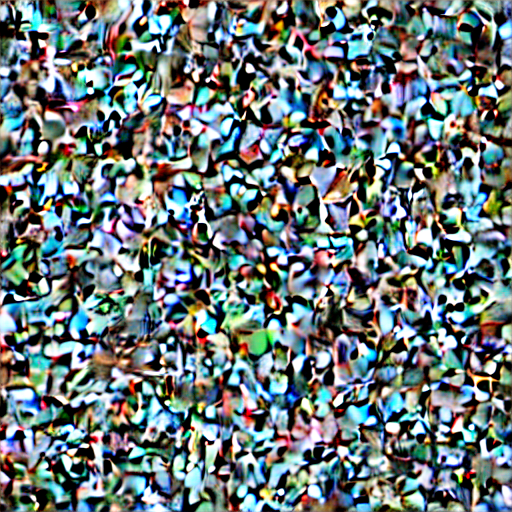
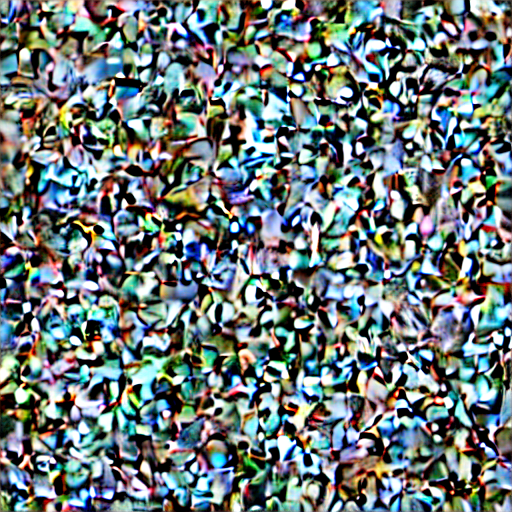
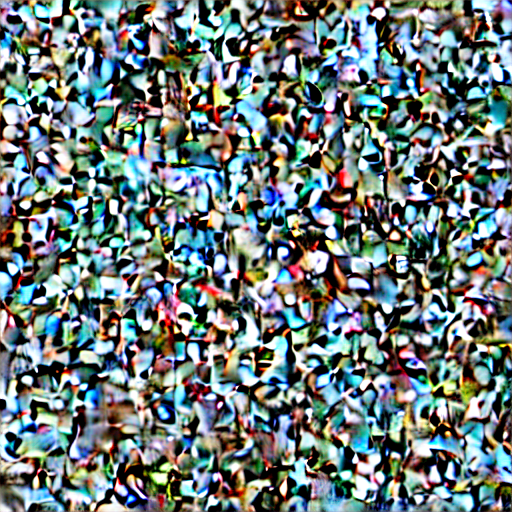
19 Dec 2022
I’m a bit behind, folks. Due to the Christmas holiday, I started writing this newletter on the 19th, but then was not able to finish it. I worked on it some more on Tuesday, December 27th, but then didn’t get back to it until today, January 1st, 2023. It doesn’t actually cover our Christmas or New Year’s celebrations at all. But if you’re reading this, whatever the date is, thanks for reading and I hope to write more regularly in 2023!
Hello friends and relations. It’s not such a beautiful day today.
We’re getting down to the shortest days of the year. As if the length of the day wasn’t short enough, over the last few days it has been very overcast and gray, so what daylight we’ve gotten has been very dim. As usual, this time of year I just want to sit around a fire and read and tell stories, maybe drinking real eggnog and taking naps. Our children have other ideas. Despite our best efforts to roll back our schedule a bit so that mom and dad get enough sleep, they’ve been keeping us up until the wee hours. Fortunately I don’t need to be at my desk early, Eastern time, but I’m still getting less sleep than I’d prefer, and lack of rest is not helping my ongoing long COVID symptoms. I know that I feel better if I get a bit more. I’m hoping that during the week between Christmas and New Year’s we can hibernate a little bit more.
Work is slow this week, as you might imagine. I think it’s true in most large, stable traditional companies, but it’s almost never true in startup or startup-like environments — often, in those environments there’s enormous pressure to finish projects before taking any time off at all — so I’m not used to it. I think I previously mentioned that I have received almost no formal onboarding, and so far none of the engineers who are more familiar with the projects have taken it upon themselves to give me any mentoring or guidance. The work culture as I’ve experienced it so far is low-key, and I’m still not used to that. So, part of my energy every day goes to just trying to calm myself down and reassure myself that I’m not about to be fired. I have gotten some useful work done — one set of changes to a project, to support testing on multiple platforms. It passes automated tests. It’s gotten one approval, but is waiting on one more. It doesn’t seem like much, compared to the pace of work that I’m accustomed to.
Previously, I mentioned that my team was having a big get-together in late January. I reached out to my boss about this. I wrote:
Hi [name redacted],
As I mentioned briefly in our last staff meeting, I will not be able to attend this event. My family of 9 is remaining cautious of COVID reinfection, as several of us are already living with long-term damage, and several of us are high-risk. I don’t believe a get-together like this can currently be safe. See:
https://www.forbes.com/sites/roberthart/2022/11/10/covid-reinfections-may-boost-chances-of-death-and-organ-failure-study-finds—and-the-risk-increases-each-time-you-catch-it/?sh=38cfb2192b2d
I sincerely hope this will not affect my prospects of continuing this contracting position, but “100% remote” was my number one requirement during my last job search, and Randstad reassured me repeatedly that this contract would not require travel.
Thanks,
Paul
He was reassuring, saying that he understood, and that they would hold some “virtual” sessions for people who could not be there in person. I can’t help but be nervous about this, though, given my past experiences with COVID minimizers in workplaces, and the number of recruiters who told me that my hopes of finding a position that would allow fully remote work were not realistic.
It’s the last work week before Christmas, and I’ll have next week off, although unfortunately it will be unpaid time off. I’ve now received two weekly paychecks, the second one for a full work week. The decline in our savings hasn’t reversed yet, but it has at least slowed. I’m trying to project things out into the first quarter of 2023, and it does look like we’ll be able to turn things around after a few months, but it will be a slow process.
An HVAC technician from Hutzel got back in touch with us and came out to take a look at our heating probems. He confirmed that a couple of zones were not working, and replaced two electronic valves (I’m not certain what they are called — they are the little boxes that turn on hot water to different zones.) It continues to be quite cold in the big upstairs room where I have my home office. Veronica’s bedroom has the same problem. This seems to be because the thermostats for both these rooms are outside the rooms. It seems like a strange installation; I think in the process of renovating the house to flip it, the previous owner didn’t want to bother re-routing wiring for thermostats, even though he had rearranged walls. I can get the heat on by temporarily setting the thermostats in the halls much higher than I actually want it, but it’s not ideal — if we leave it set that high, we’ll be over-heating other parts of the house, not to mention wasting money, and our energy bill is already shockingly high.
He also told us that it looks like our gas boiler is nearing the end of its long life. It probably has a few years left in it, but we need to start contemplating what to do next.
Let’s get into my first big topic. Please, feel absolutely free to skip over any sections you aren’t interested in. I won’t be offended. I won’t even know!
I’m not an expert on artificial intelligence, but I’m going to take a crack at explaining and discussing a recent innovation, and why it is, under the hood, both more and less impressive than it seems at first glance.
In the early years of artificial intelligence, there were many attempts to make it so that computers could “know” things, and demonstrate that they could reason about the things that they “know.” (I’m putting the word “know” in scare quotes because I think there’s a legitimate philosophical question to discuss, as to whether computers can know anything the way humans know things, and of course whether humans can ever know things, but that is far beyond the scope of what I want to talk about just now.)
Anyway, one of the most famous examples of an artificial intelligence that could “know” things is called SHRDLU:
SHRDLU was an early natural-language understanding computer program, developed by Terry Winograd at MIT in 1968–1970. In the program, the user carries on a conversation with a computer, moving objects, naming collections and querying the state of a simplified “blocks world,” essentially a virtual box filled with different blocks.
Here’s part of a transcript, taken from Terry Winograd’s web page:
Person: HAD YOU TOUCHED ANY PYRAMID BEFORE YOU PUT THE GREEN ONE ON THE LITTLE CUBE?
Computer: YES, THE GREEN ONE.
Person: WHEN DID YOU PICK IT UP?
Computer: WHILE I WAS STACKING UP THE RED CUBE, A LARGE RED BLOCK AND A LARGE GREEN CUBE.
Person: WHY?
Computer: TO GET RID OF IT.
Person: WHY DID YOU DO THAT?
Computer: TO CLEAN OFF THE RED CUBE.
Person: WHY DID YOU CLEAR OFF THAT CUBE?
Computer: TO PUT IT ON A LARGE GREEN CUBE.
Person: WHY DID YOU DO THAT?
Computer: TO STACK UP THE RED CUBE , A LARGE RED BLOCK AND A LARGE GREEN CUBE.
Person: WHY DID YOU DO THAT?
Computer: BECAUSE YOU ASKED ME TO.
Person: HOW DID YOU DO IT?
Computer: BY PUTTING A LARGE RED BLOCK ON THE TABLE ; THEN LETTING GO OF IT ; THEN PUTTING A LARGE GREEN CUBE ON IT ; THEN LETTING GO OF THAT CUBE ; THEN PUTTING THE RED CUBE ON THAT CUBE; THEN LETTING GO OF THAT CUBE.This transcript illustrates that not only does SHRDLU “know” things about the objects in its virtual world, but it also maintains a history of the things it has done in that world; note also that it took some “secondary actions” to facilitate the actions it was asked to do directly.
SHRDLU was featured in one of the books that deeply influenced my early intellectual life, Douglas Hofstadter’s Gödel, Escher, Bach: An Eternal Golden Braid. I’m not sure if I first read about it in that book; it may have been featured in something else I came across, such as Scientific American magazine. SHRDLU was built partly in Lisp and partly in a language called “Micro-Planner,” which was a “domain-specific language” or DSL, also implemented in Lisp.
Micro-Planner was a predecessor of the Prolog programming language. Prolog was, and still is, one of the most popular and most practical languages built to support logic programming. It was practical enough that in the 1990s, my team at the University of Michigan, particularly my former co-worker Alan Grover, experimented with using Prolog to generate tailored text messages based on user input, following an elaborate system of rules, although ultimately we wound up using a combination of Perl and Scheme instead. It isn’t as widely used as C++ and Java, but it remains a great example of the logic programming paradigm.
For an overview of four major programming paradigms, I highly recommend this lecture about four exemplary languages from the 1970s. (I’m using the word “exemplary” in its more literal meaning, “serving as an example of a particular school of thought,” rather than its more common meaning, “one of the best of.”) The four languages, from what the author calls “a golden age of programming languages,” are SQL, Prolog, ML, and Smalltalk. These languages represent real implementations of four important programming paradigms and so are still very relevant and worthy of study today. In that talk, Scott Wlaschin mentions another paradigm that has become so popular that most of the folks that solve problems with them don’t even realize they are doing programming: the spreadsheet.
In fact, I’d go so far as to say that I haven’t seen very many more major programming paradigms since then. Most of the big modern languages — such as JavaScript, Python, Haskell, C++, etc. — really just improve on, and blend together, those four paradigms. (In practice, languages which have good support for multiple paradigms seem to be more successful, long-term.) There have been a few other interesting programming paradigms over the years, such as stack-based languages, functional reactive languages, and dataflow languages (a spreadsheet can be considered an implementation of a dataflow language; the other widely-used one is LabVIEW), but I don’t consider these to represent all that much recent theoretical innovation.
Anyway, back to Lisp, Prolog, and Micro-Planner. Micro-Planner allowed SHRDLU to maintain a set of rules, make inferences using the rules, and create new rules, as guided by user commands. Many of the most famous examples of artificial intelligence programming from that era were built using “inference engines” that allowed computers to “know” things, at least in a limited domain, and were enough to impress the demo audience and make history.
Here’s a vintage film, unfortunately silent, showing what SHRDLU could do. Note that handling queries in fairly natural English, at least a limited subset of English, was also quite impressive for the time, although for the purposes of this discussion I want to focus on how the system is able to learn and “know” things about its simple virtual world, now how it can understand English and reply to users in English.
In late 2022, the Internet is abuzz with talk about Stable Diffusion and ChatGPT. I haven’t looked into ChatGPT much yet, but Stable Diffusion is pretty amazing. If you want to have your mind blown, take a look at this video, in which every frame was generated by Stable Diffusion.
When I first read about Stable Diffusion, I found it quite difficult to understand just how it works, since the mathematical model behind it are somewhat beyond me, and I haven’t kept up with the theory, but after experimenting with it, it started to make more sense. What follows represents my attempt to explain Stable Diffusion to non-specialists and therefore by definition can’t be completely inaccurate, but I think it should cover the basics.
At its heart, diffusion algorithms are descendants of algorithms originally designed to reduce noise in images. These kinds of thing has existed for decades; for example, some Photoshop filters can remove noise from images, but these algorithms are more sophisticated, in that they don’t just compare pixels in an image against their neighbors and smooth them out, but they apply a model, also known as a map, that guides their noise-reduction strategy, according to what the image looks like. A diffusion map is a multi-dimensional mathematical construct that (somehow; I’m leaving out a lot here) represents the information in the image, not just the pixels.
Start by imagining an algorithm that can clean up an existing image by removing noise. Imagine that this is done using a map, a multi-dimensional mathematical construct, which has been “trained” on images, so that when a noisy image comes in, the map can spit out a slightly cleaned-up image. If you like the resulting image, because it is closer to what you had in mind, you can repeat the process — you can iterate, feeding the output of the first step through the process again. That’s the core idea behind Stable Diffusion’s iterative image-processing.
What happens if you start with an image that is purely random noise — that looks like old television static? Well, the algorithm tries to clean it up, and with each iteration it tunes the noise into something that looks more like an intentional image. The results are highly dependent on the exact pattern of noise in the original image, and the way the map has been “trained.”
Now imagine that the map has been blown up into an enormously, complex, and quite large data structure. It’s been trained on hundreds of millions of existing images. The output has been evaluated and weighted by teams of humans, and it has as many as a billion values that can be adjusted: that is, “knobs you can turn” to change the way it works. Turning any of these knobs will slightly alter what might come out of an iteration.
The map isn’t “smart” like SHRDLU was. It doesn’t “know” anything about the images. It’s just a huge cloud of numbers in a multi-dimensional mathematical space, with those “knobs” (parameters) that can adjust how it works. There’s no human-readable program in MicroPlanner or any other human-readable language, although of course the tool that applies the map is implemented in code. But what it’s doing isn’t legible to a human the way the core logic of SHRDLU is; it makes its decisions based on clouds of numbers.
Since the “knobs” that adjust the behavior of the model aren’t labeled, and there are so many of them, how can the user possibly control them? Well, that’s where the text prompts come in. There are more models that are capable of mapping words in a text prompt to adjustments to the “knobs.”
Let’s start to make this more concrete: I have a version of Stable Diffusion called “DiffusionBee” running on my MacBook Air laptop. Let’s say I give it a text prompt consisting of a single word: “green.” Remember, it starts from pure noise. If I tell it to apply the algorithm once only — a single iteration — the generated images look like this:



As you can see, there is some low-level, localized structure emerging — blobs of color, a little texture — but not much. The images look like what they are: random noise that’s been slightly “de-randomized,” steered towards something a bit less random. Note also that there’s not very green. This almost looks to me like “phosphene noise” you might get when rubbing your eyes, after your visual cortex has run its own algorithms (on real neurons, not neural nets) to try to “de-noise” it into something recognizable.
As the algorithm iterates, the images rapidly start to look like they’re being steered towards something more recognizable, although where they go is different each time, dependent on the random starting conditions. Here are three from a batch I generated using two iterations:
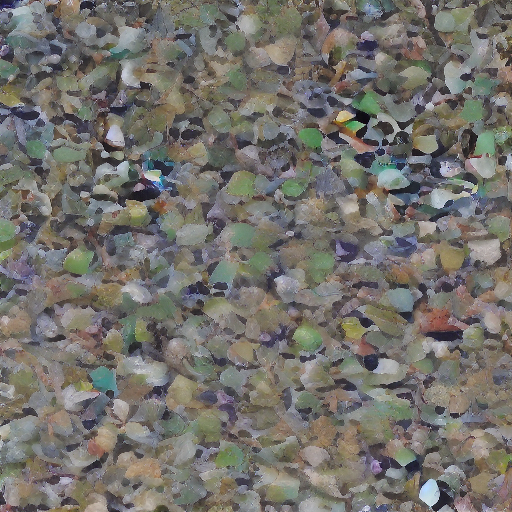
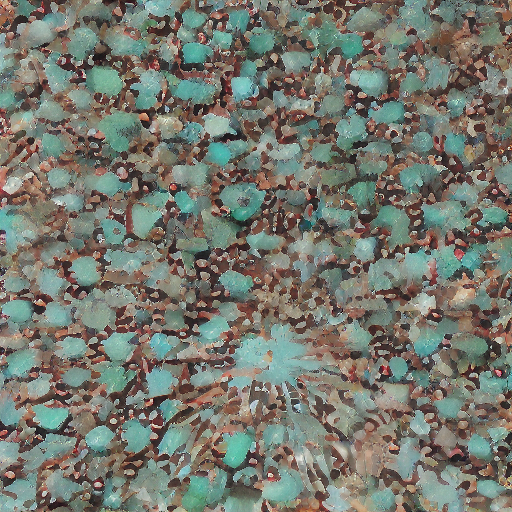
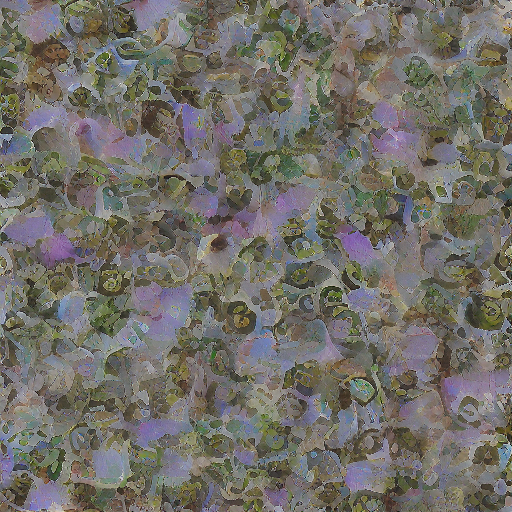
I don’t have an easy way to apply a second iteration to the images generated above, unfortunately, so it’s hard to see clearly how they start to diverge from each other, but hopefully this will get the idea across. As you can see, it’s still hard to tell where the algorithm is “going.” That’s because it doesn’t really know — remember, all it can really do is to make an image look slightly more like another image, bit by bit, by using a mathematical model that has been trained on millions of pictures, and tuned this time to head towards images to which the word “green” is somehow applicable. So, naturally, these images are looking a little more greenish. These look like they might be heading towards a picture of aquarium gravel, or maybe a succulent plant, or maybe an abstract painting.
If we take 3 steps, we can see more structure emerge, and maybe start to guess at what images the algorithm is pushing the noise towards. Maybe towards a watercolor painting, or a field of flowers, or an aerial photograph of the woods somewhere.
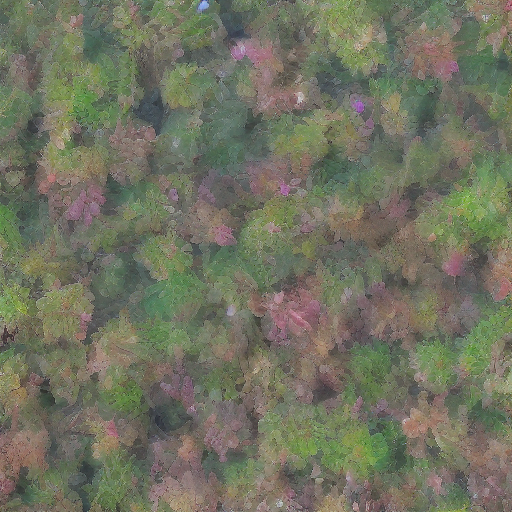
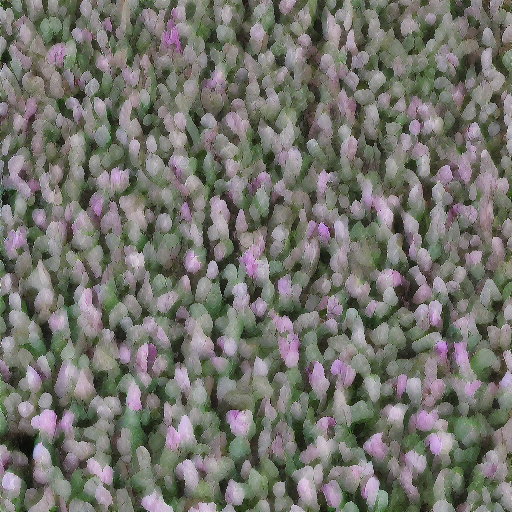
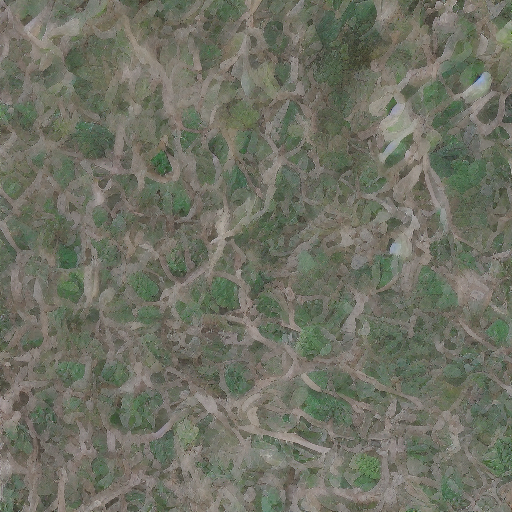
By the time we get to four iterations, we can see perhaps a field of lavender plants, or a close-up of a branching herb, or morning glories:
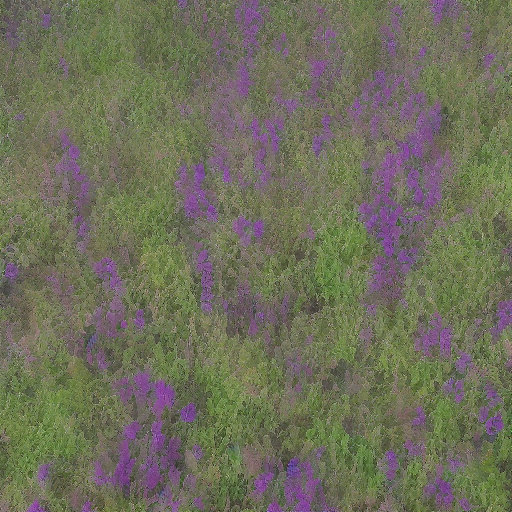
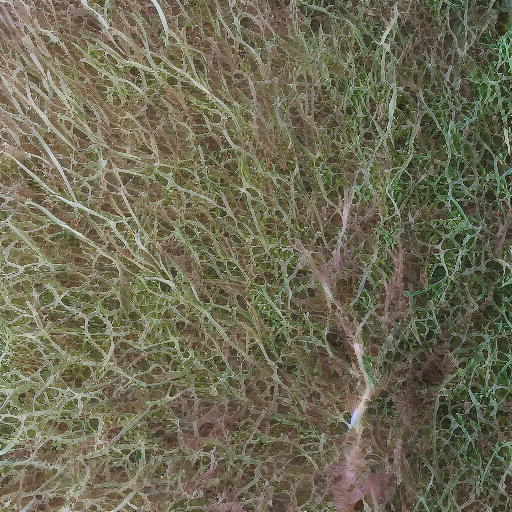

I saved examples of five and six iterations, but they aren’t that interesting; they look much like the four-iteration images. However, by the time we get to seven iterations, we usually have recognizable images, although keep in mind that they are generated; Stable Diffusion doesn’t generate an exact copy of any of the images in the corpus it was trained on. Here’s a road in a fantasy forest that probably looks somewhat like several of images that were in the training data; I’m assuming that if the code build was instrumented, and did enough logging, it might be possible to trace the output to the original training images that had the biggest influence. But it’s still a bit blurry and dream-like:

Here’s another image generated by seven iterations, which went down a very different path:
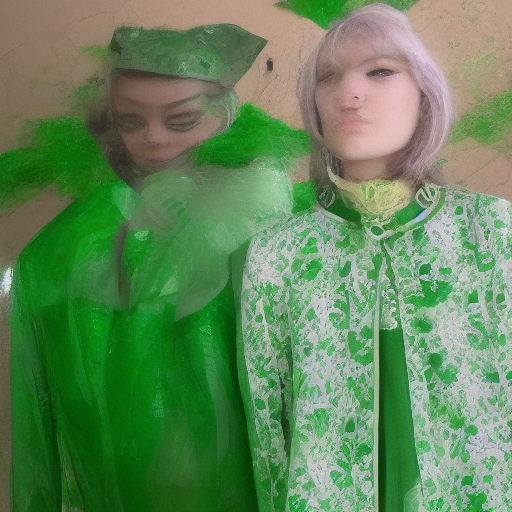
It’s interesting: with just the single prompt word, “green,” most of the images that were generated by my experiments were of women in green dresses. Maybe the training data included an over-abundance of pictures of women in green dresses. Here’s an image generated by fifty iterations:

The dressses mostly look reasonable, at least if you don’t look too closely, but the people wearing them can only be described as “pretty f****d up.” As I’ll discuss, Stable diffusion doesn’t know how many legs people have, or how fingers work. And more iterations don’t always help; twenty-five seems to be more than enough, in most cases, to get an image that is about as good as it’s going to get.
The prompts can help a lot, and a detailed prompt will often result in a much more realistic image. Here’s an image of a beetle (sort of) that doesn’t exist:
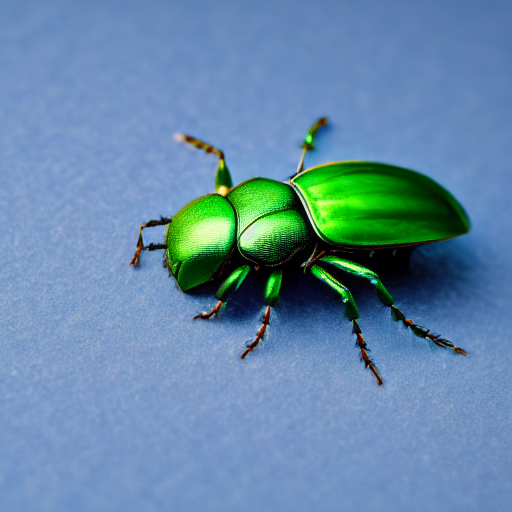
It looks like a cross between a beetle, a spider, and a bee. I generated this image using the prompt “Green beetle on a blue background, realistic photograph, high dynamic range.”
And now, here’s an image that I quite liked; I made it using the prompt “Elon Musk in a giant mech suit waving a giant glowing sword at a huge glowing blue Twitter bird logo, science fiction film scene.”
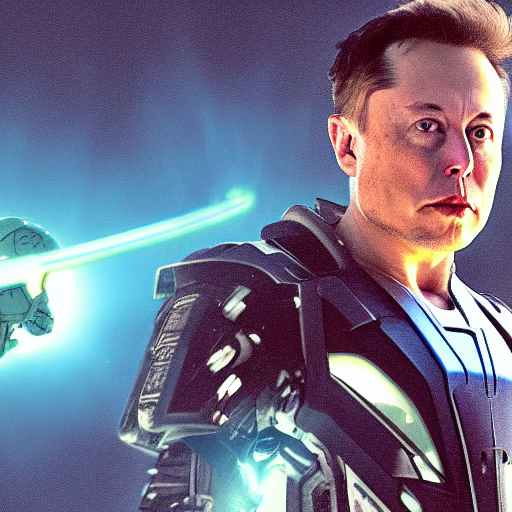
As you can see, though, he’s not in a giant mech suit, and he’s not waving a glowing sword, and there’s no Twitter bird logo. Because, I mentioned, Stable Diffusion doesn’t really know anything about the images it’s producing. Here are “six pencils lined up neatly in a row,” according to Stable Diffusion:

If I ask it to generate a nerdy boy playing with a Rubik’s Cube, it will have kind of the right idea:
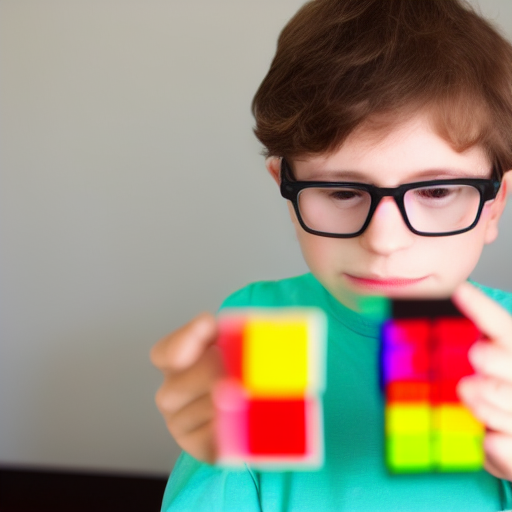

But it makes local changes to the image in each iteration. It doesn’t know that the two halves of the cube need to be attached to each other. It doesn’t know how fingers work. And you can’t ask it to explain how it got there.
The online discussion about Stable Diffusion tends to lean in several directions. A lot of people have written about how this tool is unethical because it uses the work of photographers and graphic designers without their permission.
That’s true, but much hinges on the definition of “uses” here. It doesn’t directly spit out the images it was trained on, or even portions of them. But what if Stable Diffusion’s output is used for commercial purposes — should the creators of all the images that infuenced the model to create the output get compensated, or at least credited? (I’m not sure if that is even possible, without blowing up the model to many times its current size, requiring far more memory; and what can be done if images from a hundred thousand creators demonstrably affected the image-generation process?)
What responsibility do the creators of these tools have, if the tools are used to create pornography, or other kinds of images deemed harmful? (Yes, Stable Diffusion will create sexually explicit images, and there are no doubt a lot of sexually explicit images in the training data set, although the results will tend to be more surreal and puzzling than arousing; remember that it doesn’t “know” how arms, legs, and other body parts work, or even how many of each there should be.)
What happens when real people’s faces, or images that look very much like real people’s faces, show up? Are their legal, financial, or moral obligations associated with the algorithm that has been trained on the likenesses of many, many recognizable people, and so sometimes spits out recognizable faces, especially, but not only if their names are included in the prompts? (For example, see my image of Elon Musk above; I also got a pictures of people that look vaguely like Billie Joe Armstrong and Billie Eilish accidentally, without actually mentioning their names in the text prompts, while trying to get a picture that looked approximately like Veronica:
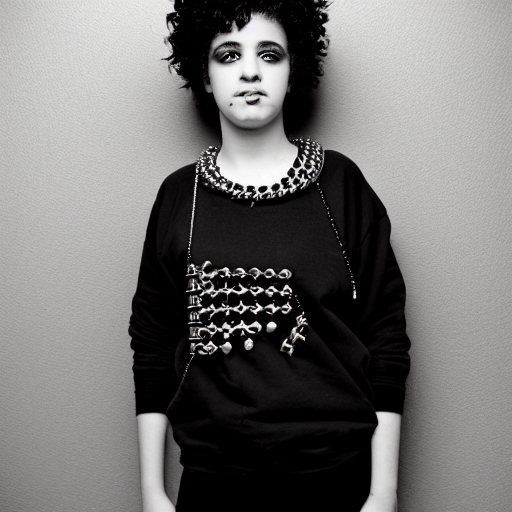
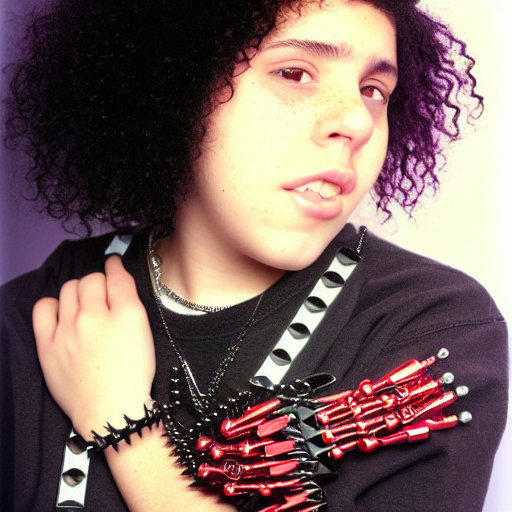
Neither of those images seems to be very exact; I can’t use the Tin Eye reverse image search to find any matches. I experimented with some services that do more approximate matches, but didn’t get any closer to finding a specific source image. But is there legal impications when the tool generates a likeness of a real person, even if isn’t an exact copy of a real photograph?
What happens when explicit images are combined with real people’s faces?
Is it possible to monetize Stable Diffusion — to make it a profitable product? And if not, how is development funded? After all, the computer power and storage required to train models on millions of images, or hundreds of images, can’t be cheap, and neither is the process of attaching textual words and phrases to source images.
It’s an amazing technology demo, but is it a useful tool for generating images for arbitrary uses, including commercial uses?
Who owns the results?
I think it might eventually make sense when used as an adjunct, or in combination, with different forms of artificial intelligence that do “know” things, such as tools with physics models in them. Such “hybrid” tools to me seem immensely promising. I’ve seen one such example already: a plug-in that allows peope to render 3-D models in Blender, and then create Stable Diffusion-generated images to wrap around their surfaces. The results of that are a bit crude-looking, like the object texture maps used in early video games, but the possibilities are there.
What do you think?
I intended to write more in this newsletter, but this little essay has taken a while to complete, so I’m going to wind up with:
Real Elanor:
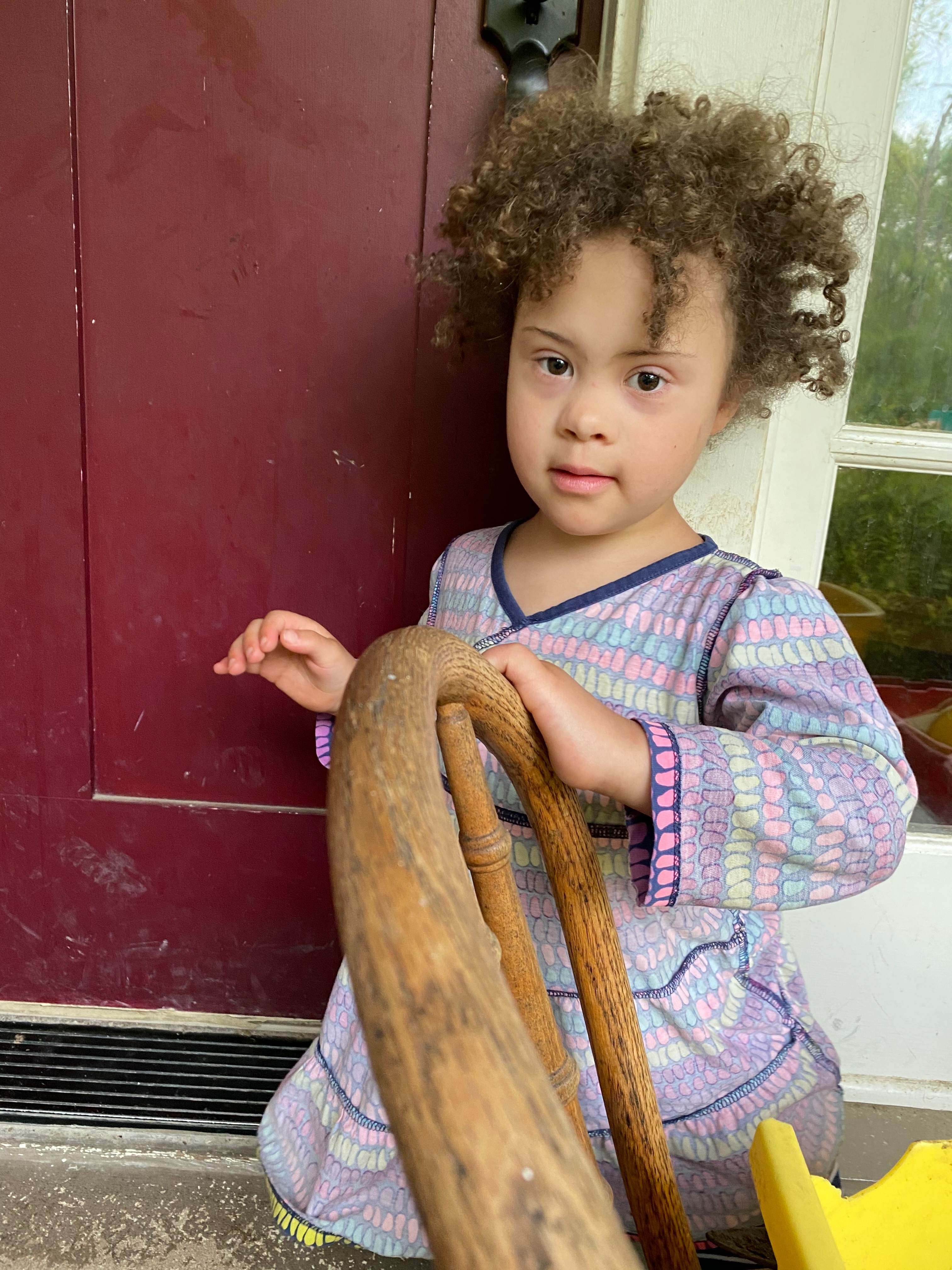
A drawing of a fake Elanor:
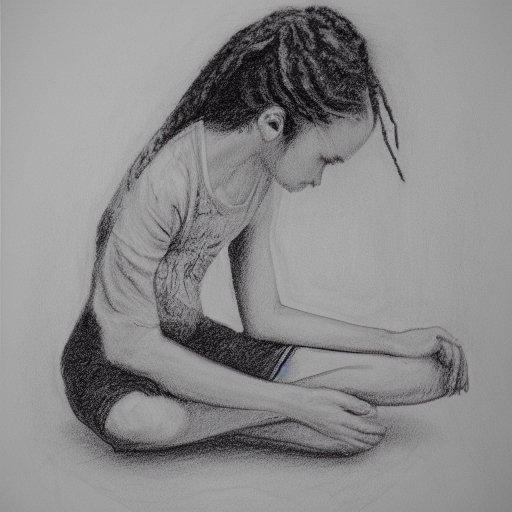
Real Malachi:

Fake Malachi:
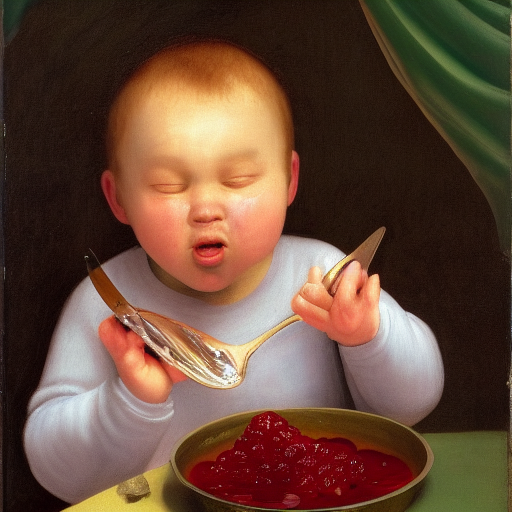
That one was generated by the text prompt “My son Boobah cryiing because we wouldn’t let him eat a spoonful of rasberry jam right out of the jar, Renaissance painting” (based on actual events).
Real Benjamin:
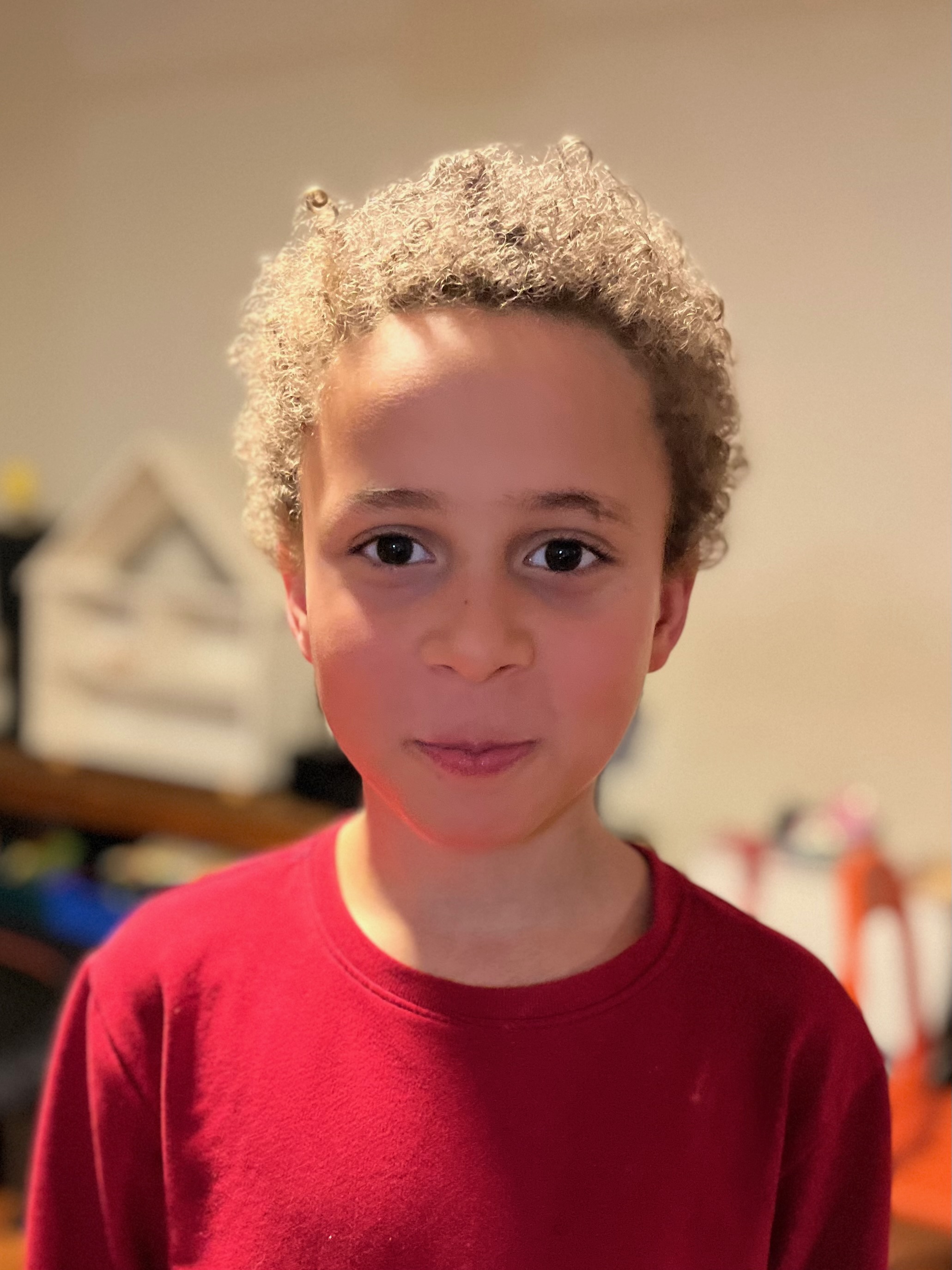
Fake Benjamin:
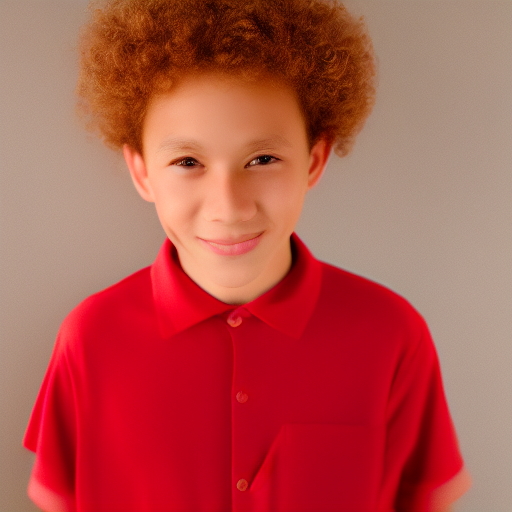
Real Daniel Peregrine (Pippin):

Fake Pippin (I wound up with many, but this one was interesting):
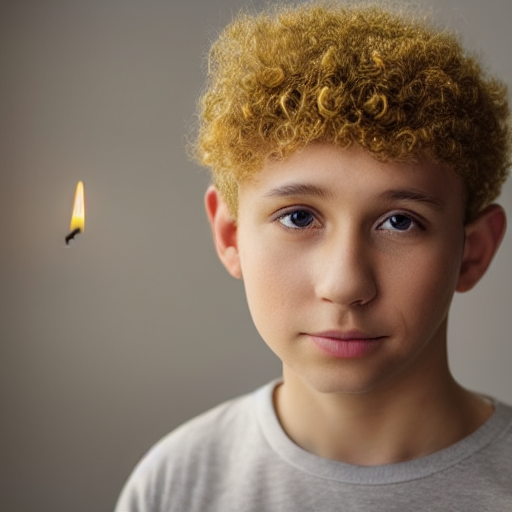
Note that my text prompt included “candles,” but somehow that turned into a single candle wick floating in space.
Real Joshua:
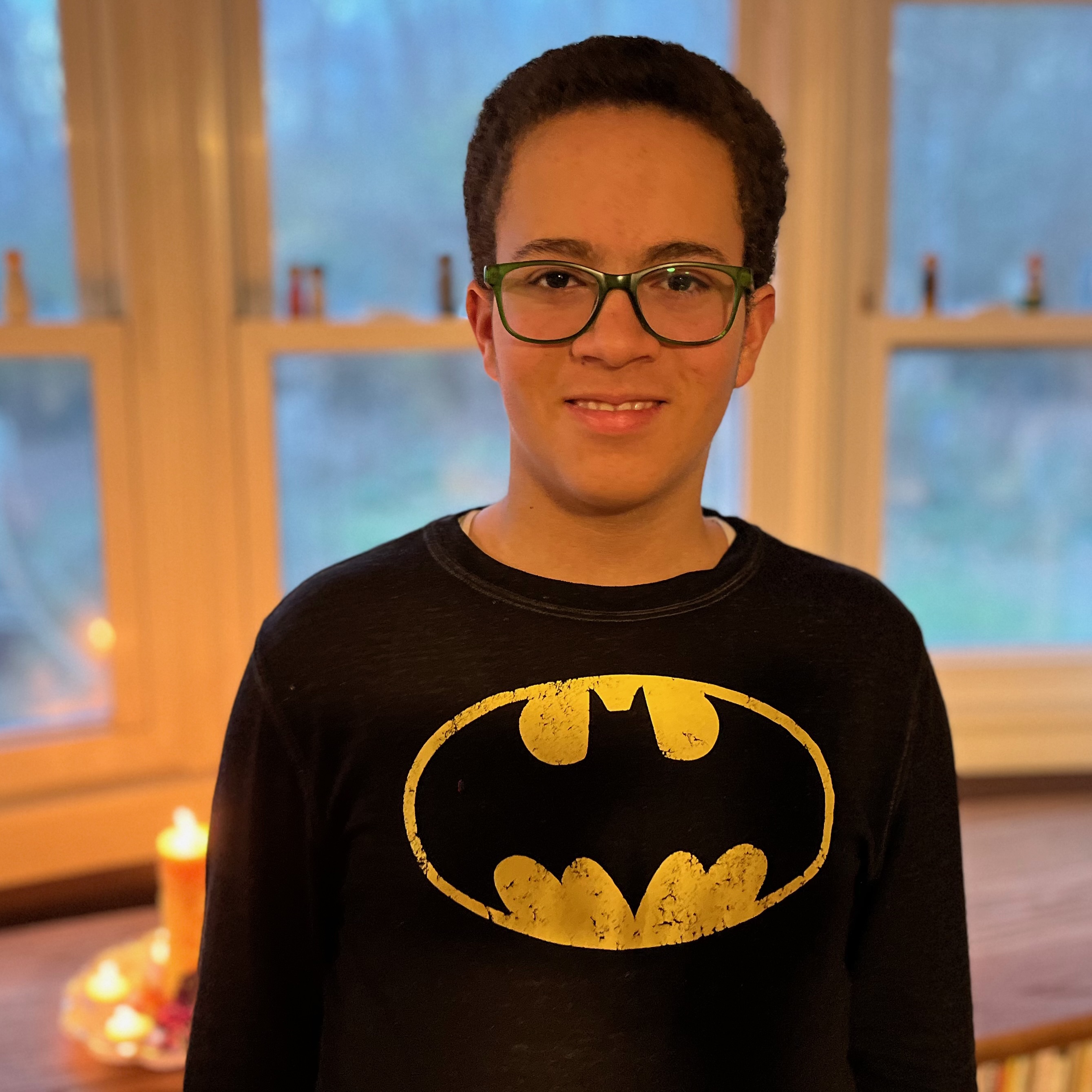
I did a number of experiments with this photograph of Joshua, including testing some alternate ways of using Stable Diffusion to create new images by extending existing images, or re-painting parts of existing images, combined with text prompts. I wound up creating some uncanny friends for Joshua; here’s one:
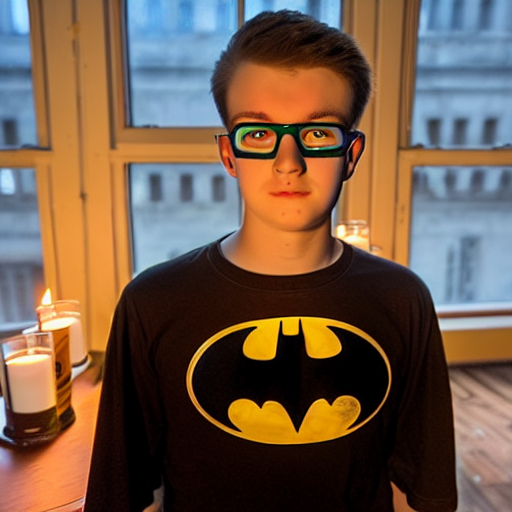
Note that it kept the windows, but changed what is seen through them, and it kept the concept of “candles,” but replaced them with a different version of the concept!
Here’s an attempt at extending the scene:
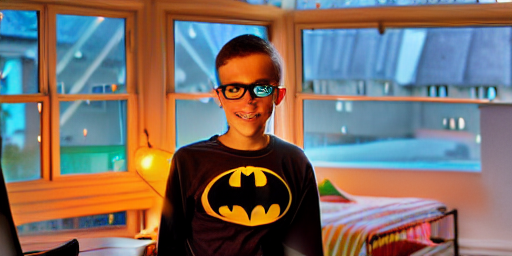
And here is an interesting result I got when I asked Stable Diffusion to repaint part of the original image of Joshua in the window, along with the text prompt describing Joshua and the candles. This picture illustrates how the algorithm can work when you don’t start it off with random noise, but with a portion of an existing image:
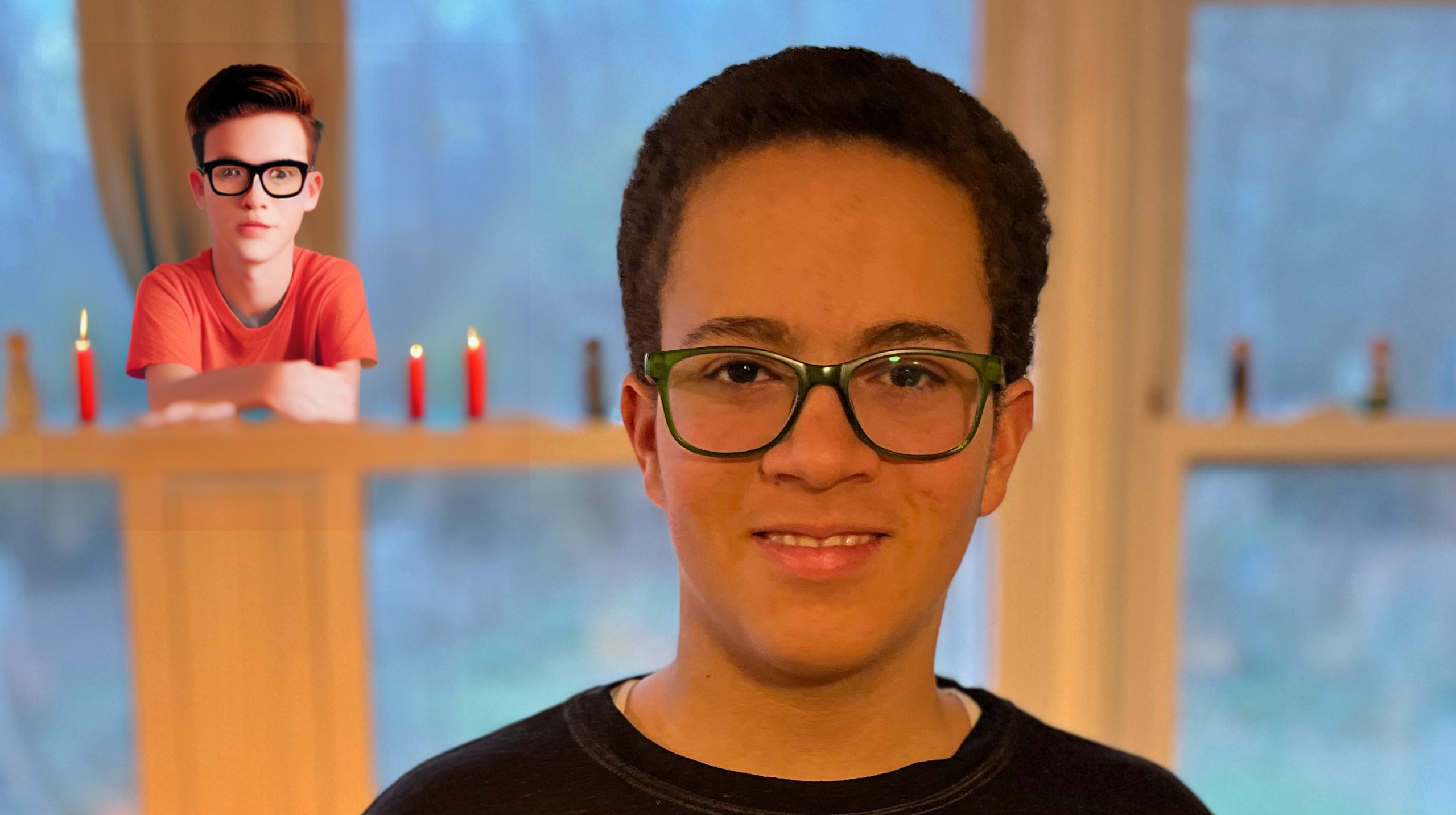
I saved this one because while the result was not realistic, it was interesting. Stable Diffusion made a little companion for Joshua, following the text prompt, and even made some more candles out of the blurry wooden peg dolls that were lined up on the window sashes. The white sash, a horizontal surface, seems to have been “tuned” into a place to put candles, probably because in the training images, candles could be often found sitting on a horizontal surface. The peg dolls themselves appear to have served as “seed shapes” that triggered the algorithm, with its “knobs” adjusted by the text prompt, to place candles there, making them progressively, on multiple iterations, look more like candles.
It did this without actually “knowing” anything about the way that candles work; note that the placement of the boy itself doesn’t make any kind of real-world, physical sense; it seems to make a kind of “image logic”. One of the seed images might have contained a boy in front of a curtained window. The vertical lines in the window frame seem to have triggered the text-prompted algorithm to draw a pattern of pixels that it associated with the word “window,” even though the prompt didn’t mention a curtain, and the original image didn’t have curtains in it.
That’s a fascinating little window, so to speak, into the way the algorithm “knows” things and “thinks” things. Is it, very generally speaking, and very broadly, akin to the way our minds, tuned by our experiences, recognize and name images, but run in reverse, “imagining” things that aren’t there?
Here’s the real Sam:
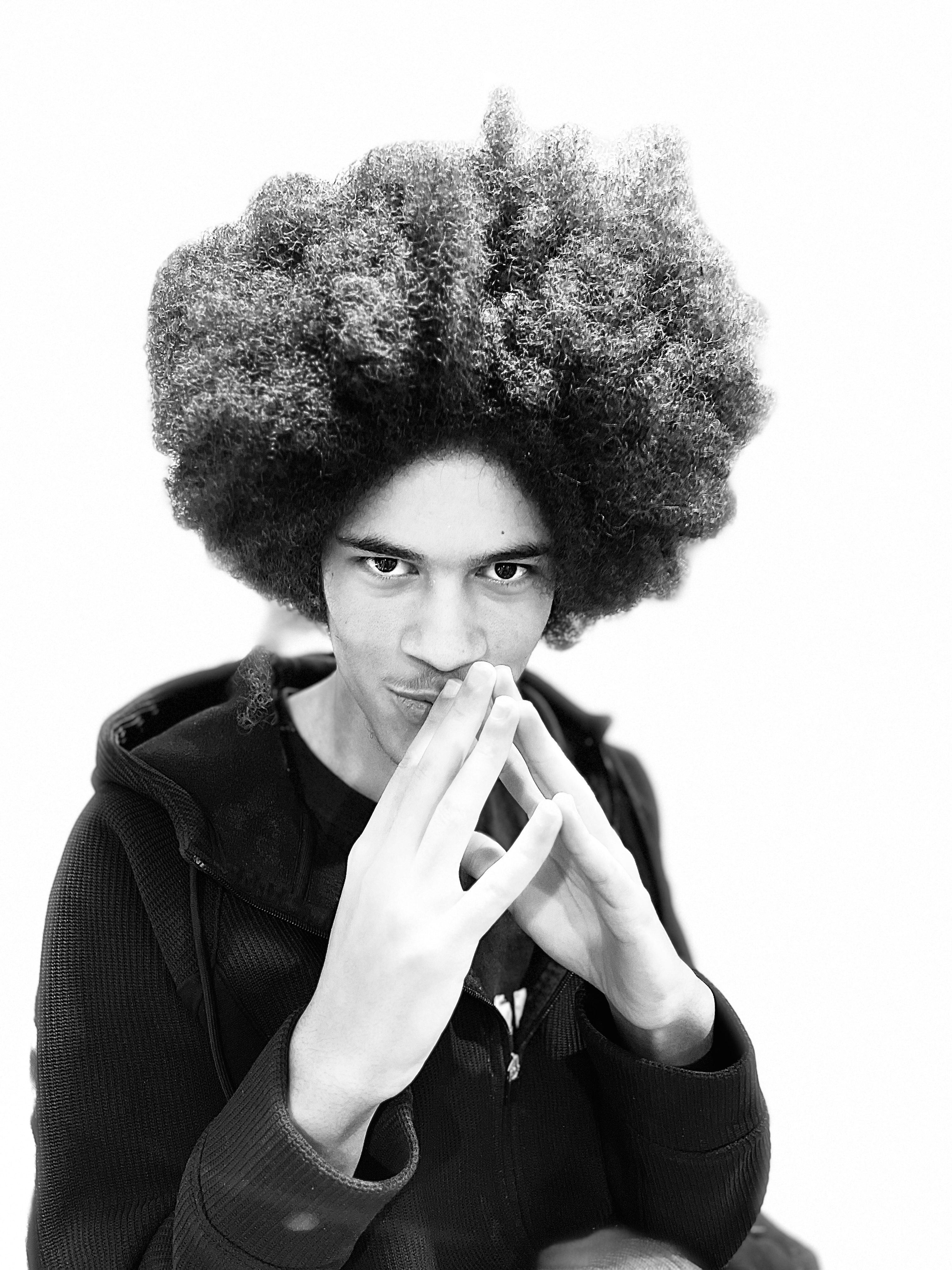
Using a text prompt, I somehow wound up getting a fake Sam that looks remarkably like the real Sam:
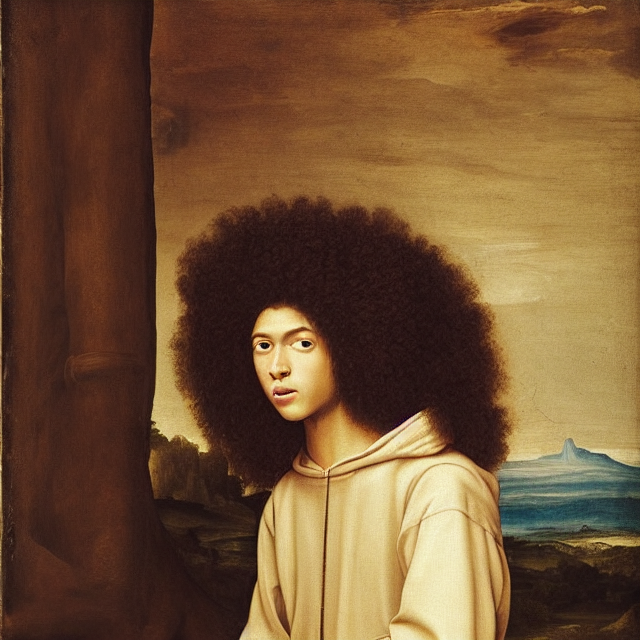
The prompt was “16 year old boy with large afro, skinny, wearing a hooded sweatshirt, Renaissance painting.” Clearly, it’s evidence that Sam will one day become a time-traveler.
Real Veronica:
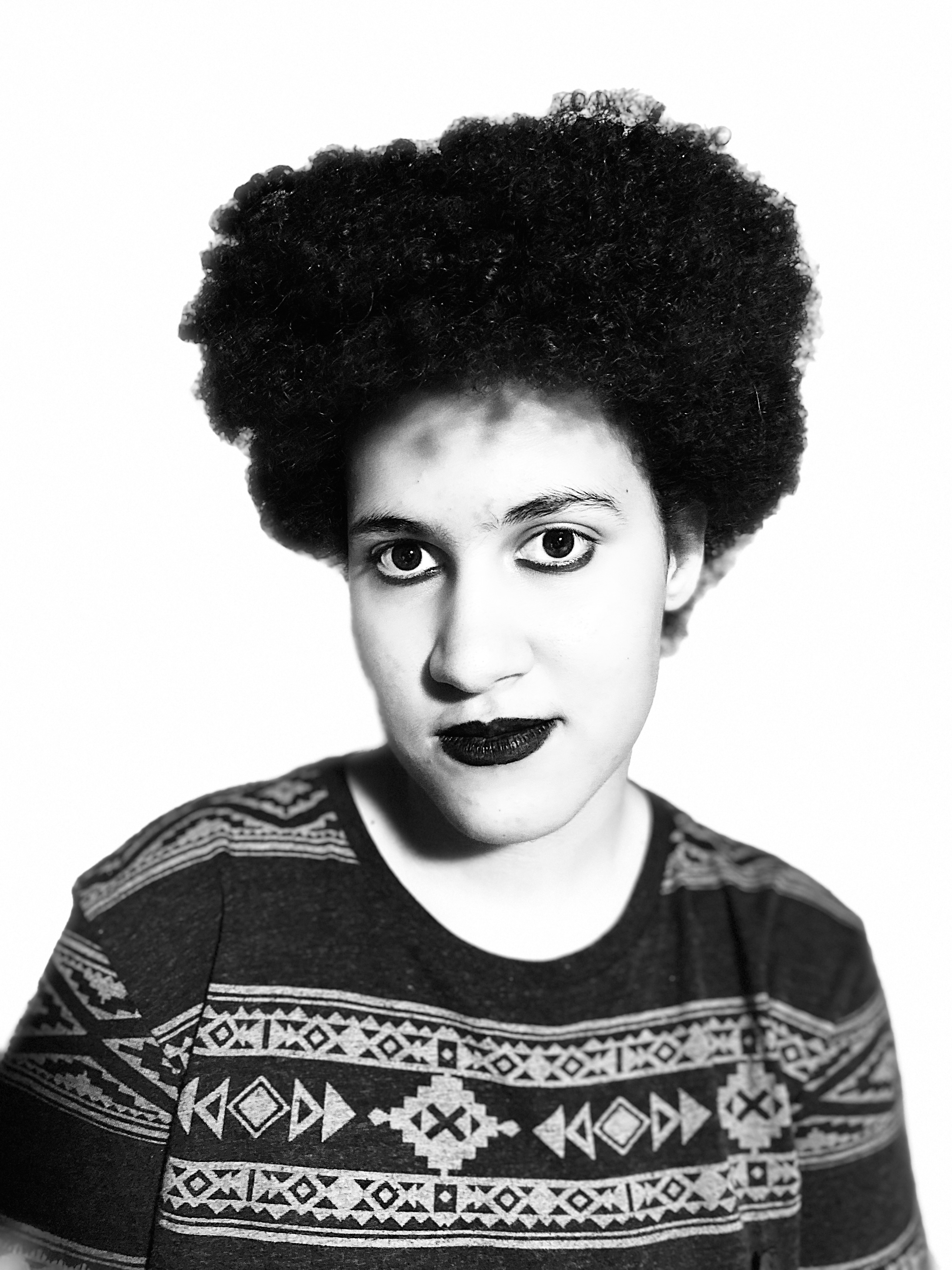
Fake Veronica:
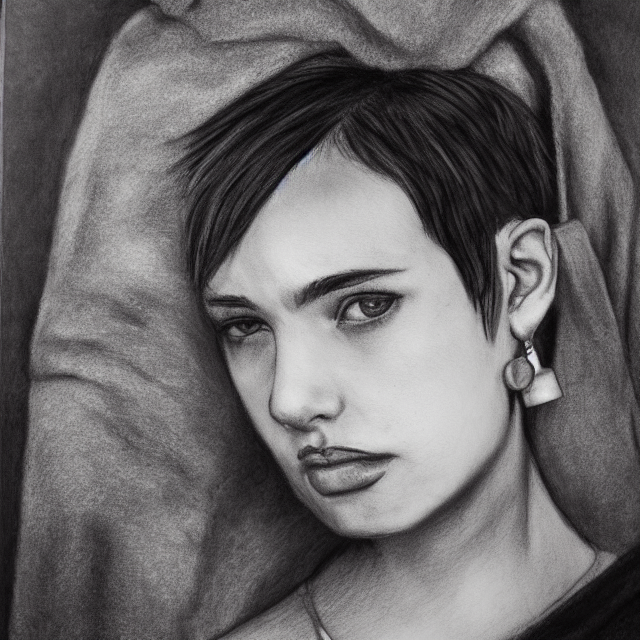
I generated the fake Veronica with the text prompt “18 year old girl with punk haircut and earings, wearing a blanket, charcoal drawing.”
And, finally, I felt that it was only fair to show you the results of my attempts to re-create myself:

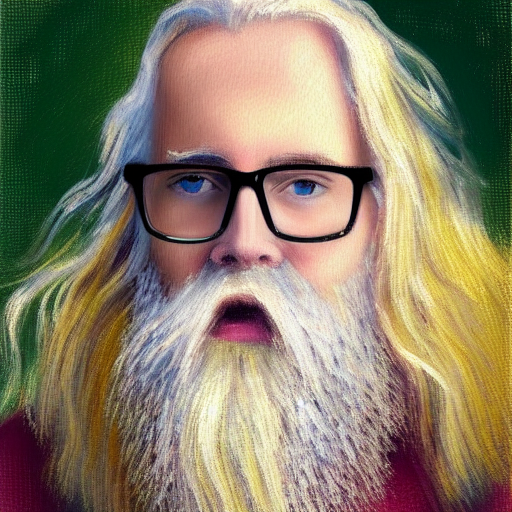
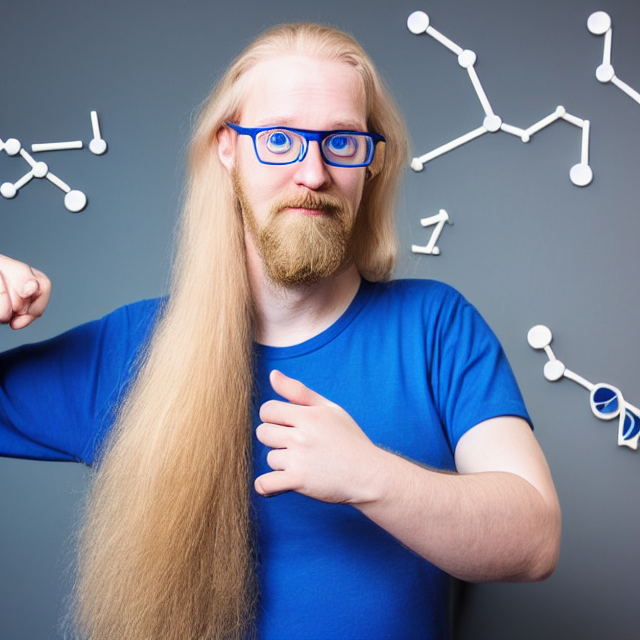
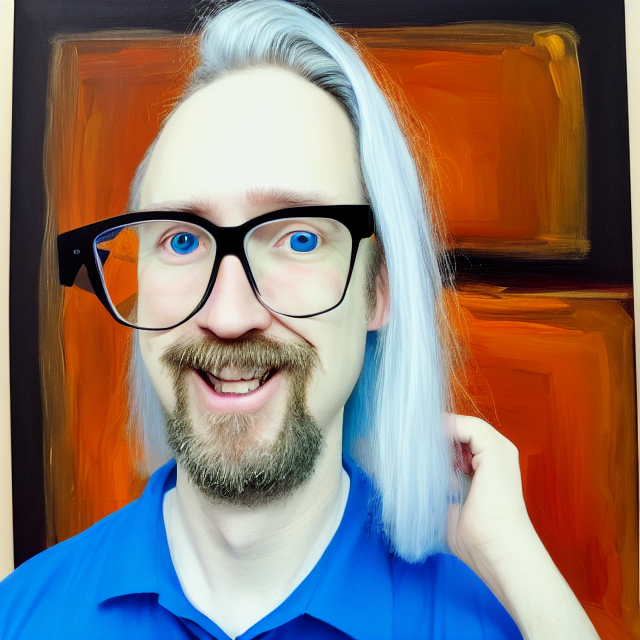

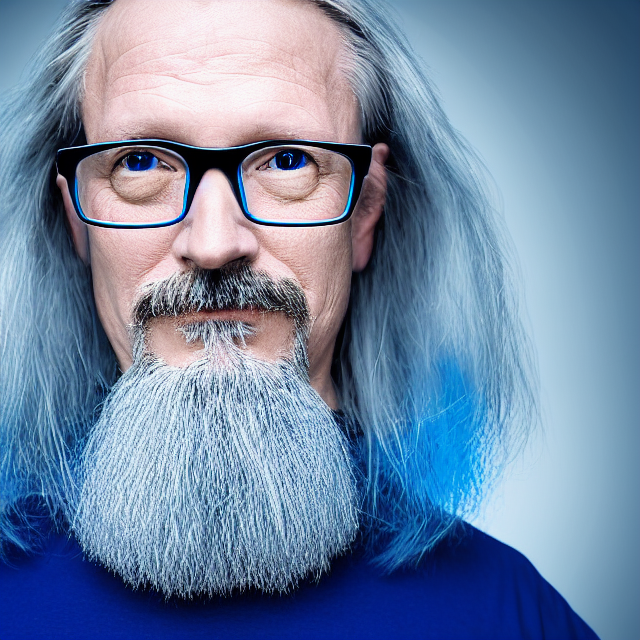
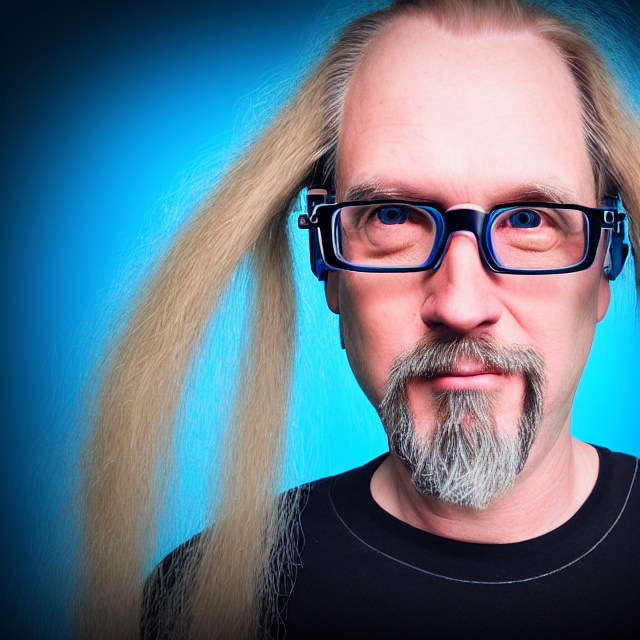
But there’s only one original:

Have a great week!
This content is available for your use under a Creative Commons Attribution-NonCommercial 4.0 International License. If you’d like to help feed my coffee habit, you can leave me a tip via PayPal. Thanks!
Subscribe via TinyLetter • Year Index • All Years Index • Writing Archive